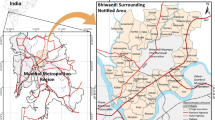Abstract
The objective of this chapter is to examine briefly the efforts for development of small and medium towns in India and to comment on some of the conceptual and operational doubts that are emerging about these efforts. Like many other developing countries, the pattern of urbanization and economic development in India are characterized by metropolitan dominance and polarization leading to inter-regional disparities and inequities in development. In countering such an undesirable process, the development of small and medium towns is seen as a strategy to encourage a more balanced urban hierarchy, and in turn to help reduce pressure on primate cities, moderate spatial inequities, enhance rural-regional development and foster embryonic or latent forces of polarization reversal. India, one of the rapidly-developing countries, has accepted the rationale of this strategy and is making efforts in this direction for more than a decade now. It may be appropriate to make an assessment of the Indian initiatives in this context in order to define orientations and directions for the future.
Access this chapter
Tax calculation will be finalised at checkout
Purchases are for personal use only
Preview
Unable to display preview. Download preview PDF.
Similar content being viewed by others
References
Balla, C. S. and A. Kundu (1982) ‘Small and Intermediate Towns in India’s Regional Development’, in O. P. Mathur (ed.), Small Cities in National Development (Nagoya, Japan: UNCRD).
Biswas, K. (1983) ‘Evolution and Implementation of the IUDP Scheme: A Policy Review’, Nagarlok, IIPA Journal, vol. XV, no. 22, April–June.
Friedman, J. P. and M. Douglas (1976) ‘Agropolitan Development: Towards a New Strategy for Regional Planning in Asia’, in (Nagoya, Japan: United Nations Centre for Regional Development) Growth Pole Strategy and Regional Development Planning in Asia, pp. 333–87.
Ganguly, R. (1986) ‘Role of Secondary Cities and the Strategy for their Integrated Planning’, Nagarlok, IIPA Journal, vol. XVIII, no. 4, October–December.
Ganguly, R. (1991) ‘Role of Small and Medium Towns in Integrating Rural-Urban Development’, IASSI Quarterly (Indian Association of Social Science Institutes) vol. 10, no. 1.
Ganguly, R. (1992) Development of Small and Medium Towns: A Review of Indian Experience with a Case Study of Gujarat State, Training Materials for Urban Managers (Calcutta: Indian Institute of Management).
Ginsburg, N. (1991) ‘Extended Metropolitan Regions in Asia: A New Spatial Paradigm’, in N. Ginsburg et al. (eds), The Extended Metropolis: Settlement Transition in Asia (University of Hawaii Press) p. 43.
Government of Gujarat (1980) Quarterly Progress Report on IDSMT, Town Planning and Valuation Department, Government of Gujarat, March.
Government of India (1974) Draft Report on the Fifth Five Year Plan (1974–79), Planning Commission, Government of India.
Government of India (1980) Annual Administrative Report, 1979–80, Ministry of Works and Housing, Government of India.
Government of India (1977) Report of the Task Force on Planning and Development of Small and Medium Towns and Cities, vol. 1, Ministry of Works and Housing, Government of India.
Government of India (1979) Centrally Sponsored Schemes for IDSMT: Guidelines, Ministry of Works and Housing, Government of India Circular dated 20 December.
Government of India (1983) Centrally Sponsored Scheme for IDSMT: Modified Guidelines, Ministry of Works and Housing, Government of India Circular dated 27 October.
IIPA (1986) Special Issue on Development of India’s Secondary Cities, Nagarlok, vol. XCIII, no. 4, October–December, Indian Institute of Public Administration, New Delhi.
Johnson, E. A. J. (1970) The Organization of Space in Developing Countries (Cambridge, Mass.: Harvard University Press).
Kundu, A. (1993) In the Name of the Urban Poor: Access to Basic Amenities (New Delhi: Sage) p. 148.
Mathur, O. P. (1982) ‘The Role of Small Cities in National Development Reexamined’, in O. P. Mathur (ed.), Small Cities in National Development (Nagoya, Japan: UNCRD).
NCU (1988) Report of the National Commission on Urbanization of India, vol. II, NCU, Government of India.
Patel, B. (1991) Assessment of the Programme for IDSMT in Gujarat, Unpublished Master’s thesis in City and Regional Planning, School of Planning, Ahmedabad.
Richardson, H. W. (1977) City Size and National Spatial Strategies in Developing Countries, World Bank Working Paper 252, April.
Rondinelli, D. A. (1983) Secondary Cities in Developing Countries (Beverley Hills, Calif.: Sage) p. 33.
United Nations (1977, 1979) World Population Trends and Policies, Monitoring Report, vol. 1 (1977); vol. 1 (1979).
Editor information
Editors and Affiliations
Copyright information
© 1997 Manas Chatterji and Yang Kaizhong
About this chapter
Cite this chapter
Ganguly, R. (1997). Integrated Development of Small and Medium Towns in India. In: Chatterji, M., Kaizhong, Y. (eds) Regional Science in Developing Countries. Palgrave Macmillan, London. https://doi.org/10.1007/978-1-349-25459-0_14
Download citation
DOI: https://doi.org/10.1007/978-1-349-25459-0_14
Publisher Name: Palgrave Macmillan, London
Print ISBN: 978-1-349-25461-3
Online ISBN: 978-1-349-25459-0
eBook Packages: Palgrave Economics & Finance CollectionEconomics and Finance (R0)




